Global Spinal Cord Stimulators Market, By Product Type, By Application, By End User, By Region & Segmental Insights Trends and Forecast, 2024 – 2034
- Industry: Healthcare
- Report ID: TNR-110-1233
- Number of Pages: 420
- Table/Charts : Yes
- July, 2024
- Base Year : 2024
- No. of Companies : 10+
- No. of Countries : 29
- Views : 10187
- Covid Impact Covered: Yes
- War Impact Covered: Yes
- Formats : PDF, Excel, PPT
Spinal cord stimulators (SCS) are medical devices used primarily to manage chronic pain. They work by sending electrical impulses to the spinal cord to modulate pain signals before they reach the brain. The spinal cord stimulators (SCS) market is experiencing robust growth, driven by increasing prevalence of chronic pain conditions and advancements in stimulation technologies. Opportunities in the market are expanding due to the rising adoption of minimally invasive procedures and growing patient awareness of alternative pain management solutions.
Innovations such as adaptive and burst stimulation systems are enhancing treatment efficacy and patient outcomes, further fuelling market growth. Expanding healthcare infrastructure in emerging economies is broadening market reach. Growth drivers include the escalating demand for non-opioid pain management options, technological advancements improving device performance, and supportive regulatory frameworks. These factors collectively contribute to a dynamic and evolving market landscape, offering significant potential for stakeholders. In Terms of Revenue, the Global Spinal Cord Stimulators Market was Worth US$ 4.3 Bn in 2023, Anticipated to Witness CAGR of 7.8% During 2024 – 2034.
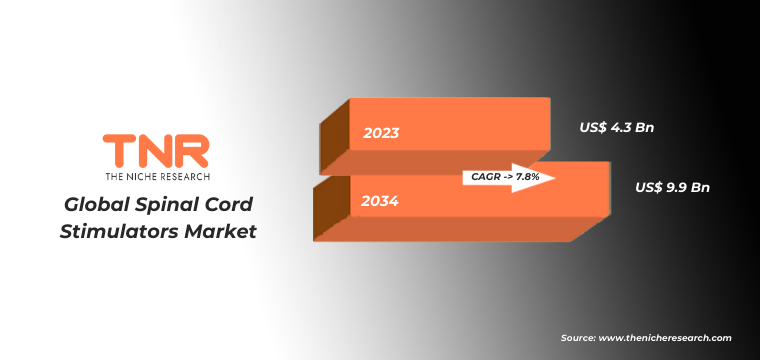
Opportunities in the Global Spinal Cord Stimulators Market
- Technological Advancements: Innovations such as closed-loop systems, adaptive stimulation, and burst stimulation are enhancing the effectiveness and customization of pain management solutions. These advanced technologies offer tailored treatment plans, improving patient outcomes and satisfaction. As manufacturers invest in research and development to integrate cutting-edge features and improve device functionality, there is a significant opportunity for market expansion. Enhanced technological capabilities also attract a broader patient base and increase market adoption rates, particularly in regions with growing healthcare infrastructure.
- Emerging Market Penetration: Rapid economic growth and expanding healthcare infrastructure in regions like Asia-Pacific and Latin America are driving increased demand for advanced pain management solutions. The rising prevalence of chronic pain conditions and a shift towards minimally invasive treatments in these regions support market entry. Additionally, increasing healthcare expenditure and improving access to medical technologies in developing countries are creating new opportunities for market players to expand their footprint and capture a larger share of the global market.
Rechargeable by product type category have emerged as a dominant segment in the global spinal cord stimulators market due to their enhanced convenience and extended operational lifespan. Unlike non-rechargeable models, rechargeable devices offer the advantage of longer-lasting power, reducing the need for frequent battery replacements and subsequent surgical interventions. This results in lower long-term costs and increased patient satisfaction. Advancements in battery technology and design have improved the reliability and efficiency of rechargeable systems, making them more attractive to both patients and healthcare providers. The ability to recharge the device also aligns with the growing preference for minimally invasive solutions and personalized care, further driving the adoption of rechargeable spinal cord stimulators in the market.
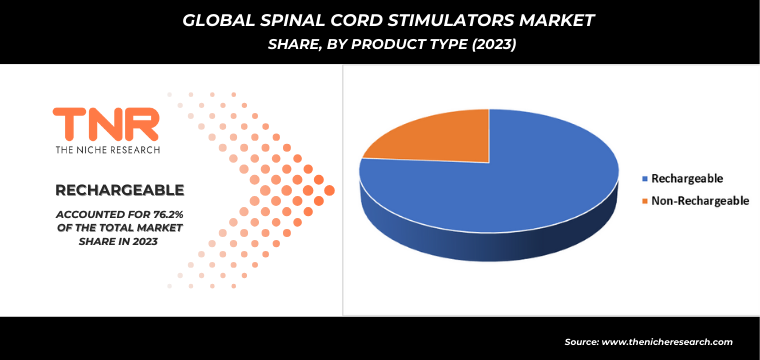
In 2023, failed back surgery syndrome (FBSS) segment solidified its position as the second-largest application category within the global spinal cord stimulators market. This is attributed to the significant prevalence of FBSS among patients who have not found relief through traditional back surgeries. Spinal cord stimulators offer an effective alternative by modulating pain signals, providing substantial relief to individuals suffering from persistent pain post-surgery. The increasing recognition of SCS as a viable treatment option for FBSS, combined with advancements in device technology and growing awareness among healthcare professionals, has driven substantial market growth. The rising number of surgeries and subsequent FBSS cases underscores the continued demand for innovative pain management solutions.
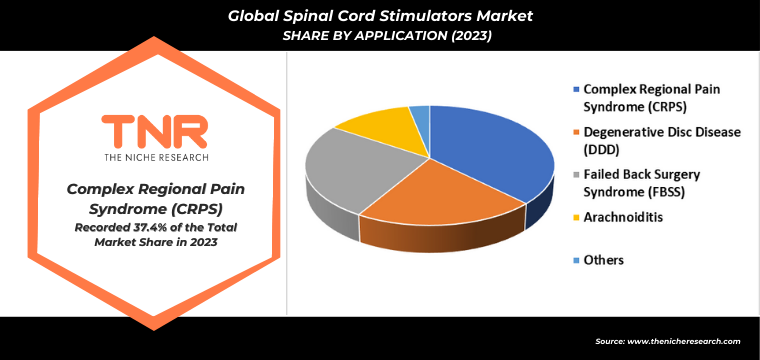
By end user, ambulatory surgical centers segment is anticipated to grow fastest over the forecast timeline in global spinal cord stimulators market. This rapid expansion is driven by the increasing preference for outpatient procedures and the growing trend towards minimally invasive surgeries, which ASCs are well-equipped to handle. ASCs offer a cost-effective and efficient alternative to traditional hospital settings, appealing to both patients and healthcare providers. Their ability to provide high-quality care with shorter recovery times and lower operational costs enhances their attractiveness for spinal cord stimulator procedures. Advancements in surgical technologies and improved patient outcomes contribute to the rising adoption of spinal cord stimulators in ASCs, positioning them as a key growth driver in the market.

In 2023, Europe solidified its dominance in the global spinal cord stimulators market, contributing a revenue share of 25.5%. This strong performance is attributed to the region’s advanced healthcare infrastructure, high adoption rates of innovative medical technologies, and robust regulatory frameworks that support the use of spinal cord stimulators. European countries, such as Germany, France, and the UK, have seen increased demand for advanced pain management solutions due to a growing prevalence of chronic pain conditions and a preference for minimally invasive procedures. Europe’s well-established healthcare systems and the presence of key market players contribute to its leading position in the global market, reinforcing its pivotal role in driving growth and innovation.
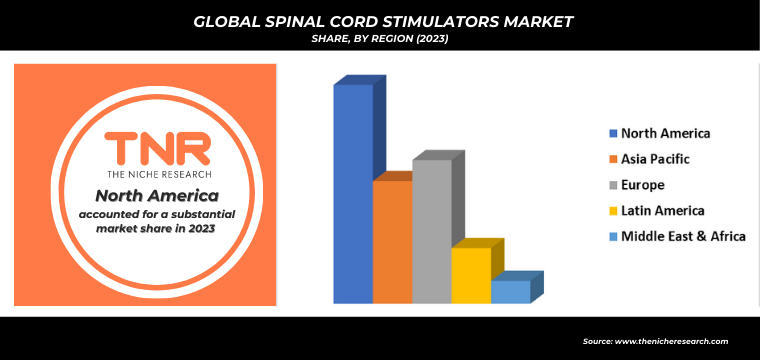
Competitive Landscape
Some of the players operating in the spinal cord stimulators market are
- Abbott Laboratories
- Axonics Modulation Technologies, Inc.
- Boston Scientific Corporation
- Cyberonics, Inc.
- Inspire Medical Systems, Inc.
- Integer Holdings Corporation
- LivaNova PLC
- Medtronic
- NeuroSigma, Inc.
- Nevro Corp.
- Nuvectra Corporation
- ReShape Lifesciences Inc.
- Saluda Medical Pty Ltd
- SPR Therapeutics, Inc.
- StimGuard LLC.
- Stimwave LLC
- Stryker Corporation
- Synapse Biomedical Inc.
- Zynex, Inc.
- Other Industry Participants
Global Spinal Cord Stimulators Market Scope
| Report Specifications | Details |
| Market Revenue in 2023 | US$ 4.3 Bn |
| Market Size Forecast by 2034 | US$ 9.9 Bn |
| Growth Rate (CAGR) | 7.8% |
| Historic Data | 2016 – 2022 |
| Base Year for Estimation | 2023 |
| Forecast Period | 2024 – 2034 |
| Report Inclusions | Market Size & Estimates, Market Dynamics, Competitive Scenario, Trends, Growth Factors, Market Determinants, Key Investment Segmentation, Product/Service/Solutions Benchmarking |
| Segments Covered | By Product Type, By Application, By End User, By Region |
| Regions Covered | North America, Europe, Asia Pacific, Middle East & Africa, Latin America |
| Countries Covered | U.S., Canada, Mexico, Rest of North America, France, The UK, Spain, Germany, Italy, Nordic Countries (Denmark, Finland, Iceland, Sweden, Norway), Benelux Union (Belgium, The Netherlands, Luxembourg), Rest of Europe, China, Japan, India, New Zealand, Australia, South Korea, Southeast Asia (Indonesia, Thailand, Malaysia, Singapore, Rest of Southeast Asia), Rest of Asia Pacific, Saudi Arabia, UAE, Egypt, Kuwait, South Africa, Rest of Middle East & Africa, Brazil, Argentina, Rest of Latin America |
| Key Players | Abbott Laboratories, Axonics Modulation Technologies, Inc., Boston Scientific Corporation, Cyberonics, Inc., Inspire Medical Systems, Inc., Integer Holdings Corporation, LivaNova PLC, Medtronic, NeuroSigma, Inc., Nevro Corp., Nuvectra Corporation, ReShape Lifesciences Inc., Saluda Medical Pty Ltd, SPR Therapeutics, Inc., StimGuard LLC., Stimwave LLC, Stryker Corporation, Synapse Biomedical Inc., Zynex, Inc. |
| Customization Scope | Customization allows for the inclusion/modification of content pertaining to geographical regions, countries, and specific market segments. |
| Pricing & Procurement Options | Explore purchase options tailored to your specific research requirements |
| Contact Details | Consult With Our Expert
Japan (Toll-Free): +81 663-386-8111 South Korea (Toll-Free): +82-808- 703-126 Saudi Arabia (Toll-Free): +966 800-850-1643 United Kingdom: +44 753-710-5080 United States: +1 302-232-5106 E-mail: askanexpert@thenicheresearch.com
|
Global Spinal Cord Stimulators Market
By Product Type
- Rechargeable
- Non-Rechargeable
By Application
- Complex Regional Pain Syndrome (CRPS)
- Degenerative Disc Disease (DDD)
- Failed Back Surgery Syndrome (FBSS)
- Arachnoiditis
- Others
By End User
- Hospitals
- Ambulatory Surgical Centers
- Specialty Clinics
- Others
By Region
- North America (U.S., Canada, Mexico, Rest of North America)
- Europe (France, The UK, Spain, Germany, Italy, Nordic Countries (Denmark, Finland, Iceland, Sweden, Norway), Benelux Union (Belgium, The Netherlands, Luxembourg), Rest of Europe)
- Asia Pacific (China, Japan, India, New Zealand, Australia, South Korea, Southeast Asia (Indonesia, Thailand, Malaysia, Singapore, Rest of Southeast Asia), Rest of Asia Pacific)
- Middle East & Africa (Saudi Arabia, UAE, Egypt, Kuwait, South Africa, Rest of Middle East & Africa)
- Latin America (Brazil, Argentina, Rest of Latin America)
Report Layout:
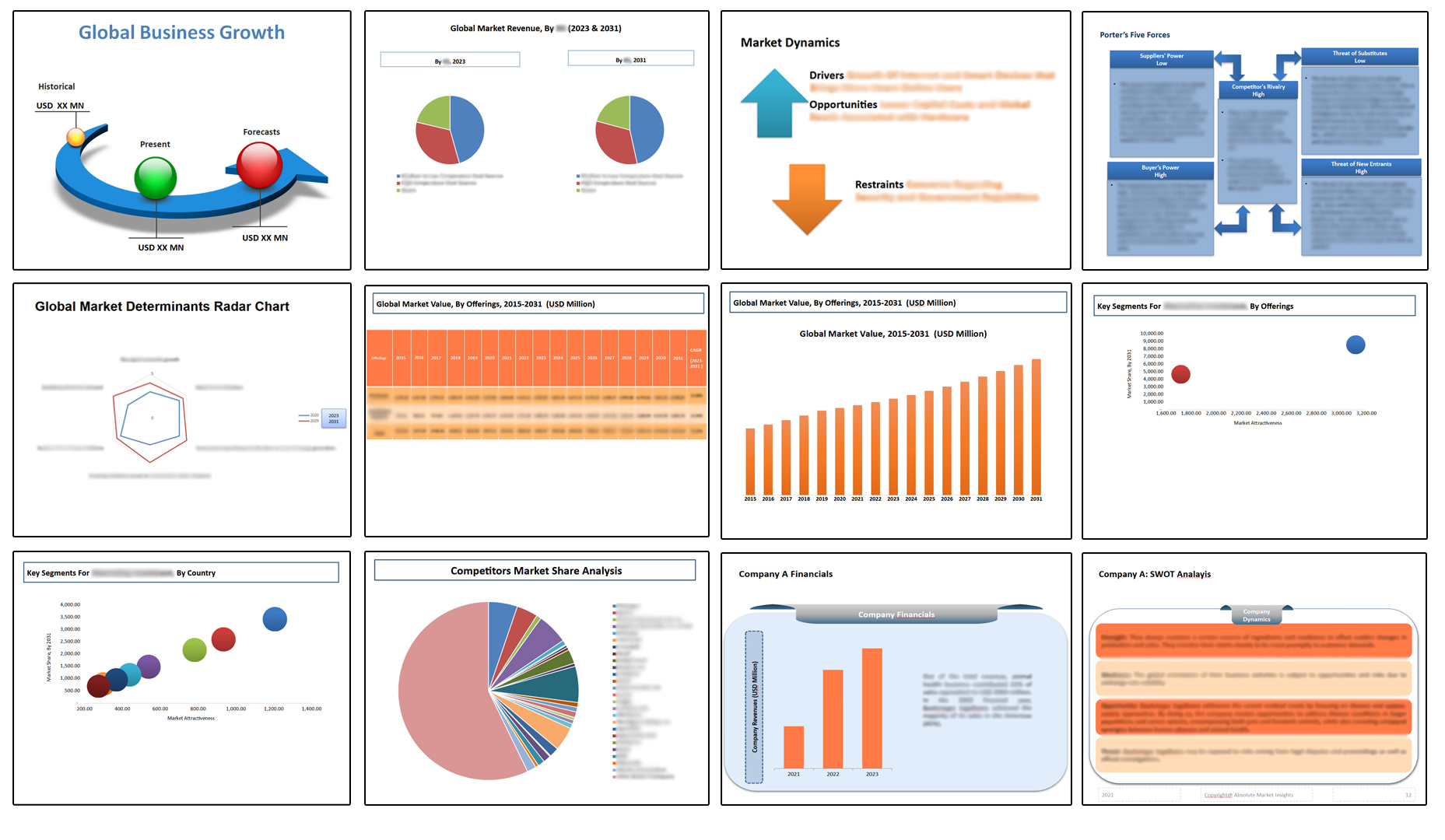
Table of Contents
Note: This ToC is tentative and can be changed according to the research study conducted during the course of report completion.
**Exclusive for Multi-User and Enterprise User.
Global Spinal Cord Stimulators Market
By Product Type
- Rechargeable
- Non-Rechargeable
By Application
- Complex Regional Pain Syndrome (CRPS)
- Degenerative Disc Disease (DDD)
- Failed Back Surgery Syndrome (FBSS)
- Arachnoiditis
- Others
By End User
- Hospitals
- Ambulatory Surgical Centers
- Specialty Clinics
- Others
By Region
- North America (U.S., Canada, Mexico, Rest of North America)
- Europe (France, The UK, Spain, Germany, Italy, Nordic Countries (Denmark, Finland, Iceland, Sweden, Norway), Benelux Union (Belgium, The Netherlands, Luxembourg), Rest of Europe)
- Asia Pacific (China, Japan, India, New Zealand, Australia, South Korea, Southeast Asia (Indonesia, Thailand, Malaysia, Singapore, Rest of Southeast Asia), Rest of Asia Pacific)
- Middle East & Africa (Saudi Arabia, UAE, Egypt, Kuwait, South Africa, Rest of Middle East & Africa)
- Latin America (Brazil, Argentina, Rest of Latin America)
The Niche Research approach encompasses both primary and secondary research methods to provide comprehensive insights. While primary research is the cornerstone of our studies, we also incorporate secondary research sources such as company annual reports, premium industry databases, press releases, industry journals, and white papers.
Within our primary research, we actively engage with various industry stakeholders, conducting paid interviews and surveys. Our meticulous analysis extends to every market participant in major countries, allowing us to thoroughly examine their portfolios, calculate market shares, and segment revenues.
Our data collection primarily focuses on individual countries within our research scope, enabling us to estimate regional market sizes. Typically, we employ a bottom-up approach, meticulously tracking trends in different countries. We analyze growth drivers, constraints, technological innovations, and opportunities for each country, ultimately arriving at regional figures.Our process begins by examining the growth prospects of each country. Building upon these insights, we project growth and trends for the entire region. Finally, we utilize our proprietary model to refine estimations and forecasts.
Our data validation standards are integral to ensuring the reliability and accuracy of our research findings. Here’s a breakdown of our data validation processes and the stakeholders we engage with during our primary research:
- Supply Side Analysis: We initiate a supply side analysis by directly contacting market participants, through telephonic interviews and questionnaires containing both open-ended and close-ended questions. We gather information on their portfolios, segment revenues, developments, and growth strategies.
- Demand Side Analysis: To gain insights into adoption trends and consumer preferences, we reach out to target customers and users (non-vendors). This information forms a vital part of the qualitative analysis section of our reports, covering market dynamics, adoption trends, consumer behavior, spending patterns, and other related aspects.
- Consultant Insights: We tap into the expertise of our partner consultants from around the world to obtain their unique viewpoints and perspectives. Their insights contribute to a well-rounded understanding of the markets under investigation.
- In-House Validation: To ensure data accuracy and reliability, we conduct cross-validation of data points and information through our in-house team of consultants and utilize advanced data modeling tools for thorough verification.
The forecasts we provide are based on a comprehensive assessment of various factors, including:
- Market Trends and Past Performance (Last Five Years): We accurately analyze market trends and performance data from preceding five years to identify historical patterns and understand the market’s evolution.
- Historical Performance and Growth of Market Participants: We assess the historical performance and growth trajectories of key market participants. This analysis provides insights into the competitive landscape and individual company strategies.
- Market Determinants Impact Analysis (Next Eight Years): We conduct a rigorous analysis of the factors that are projected to influence the market over the next eight years. This includes assessing both internal and external determinants that can shape market dynamics.
- Drivers and Challenges for the Forecast Period:Identify the factors expected to drive market growth during the forecast period, as well as the challenges that the industry may face. This analysis aids in deriving an accurate growth rate projection.
- New Acquisitions, Collaborations, or Partnerships: We keep a close watch on any new acquisitions, collaborations, or partnerships within the industry. These developments can have a significant impact on market dynamics and competitiveness.
- Macro and Micro Factors Analysis:A thorough examination of both macro-level factors (e.g., economic trends, regulatory changes) and micro-level factors (e.g., technological advancements, consumer preferences) that may influence the market during the forecast period.
- End-User Sentiment Analysis: To understand the market from the end-user perspective, we conduct sentiment analysis. This involves assessing the sentiment, preferences, and feedback of the end-users, which can provide valuable insights into market trends.
- Perspective of Primary Participants: Insights gathered directly from primary research participants play a crucial role in shaping our forecasts. Their perspectives and experiences provide valuable qualitative data.
- Year-on-Year Growth Trend: We utilize a year-on-year growth trend based on historical market growth and expected future trends. This helps in formulating our growth projections, aligning them with the market’s historical performance.
Research process adopted by TNR involves multiple stages, including data collection, validation, quality checks, and presentation. It’s crucial that the data and information we provide add value to your existing market understanding and expertise. We have also established partnerships with business consulting, research, and survey organizations across regions and globally to collaborate on regional analysis and data validation, ensuring the highest level of accuracy and reliability in our reports.









